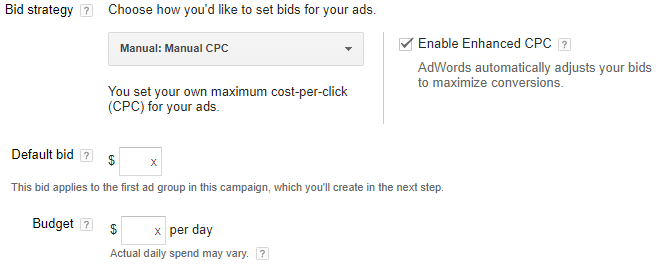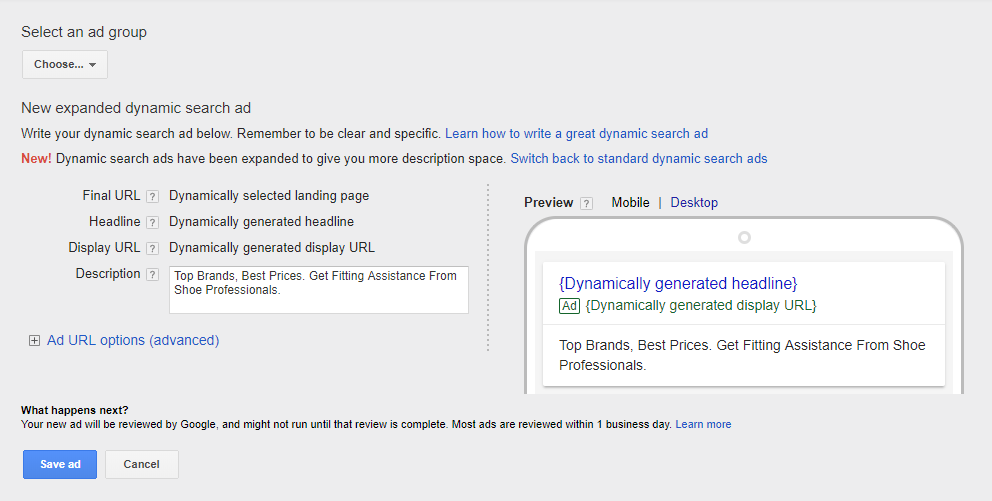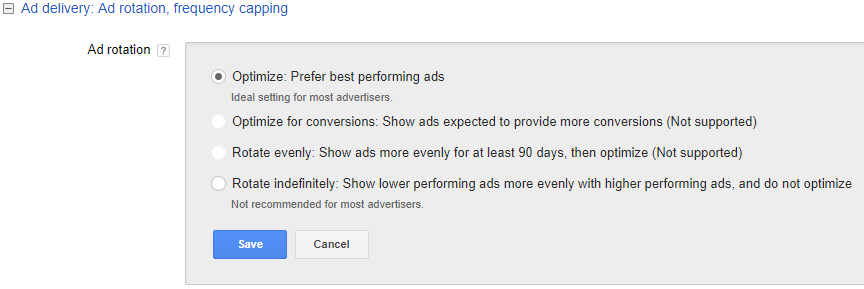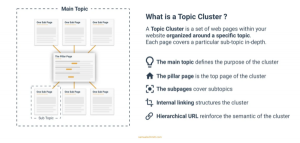— April 11, 2018
In AdWords, every view, click, or lost click has either a cost or opportunity cost. Fine margins are often the difference between losing money or profitability, and negligence can cost far more than you think.
These advanced tactics can help to turn your AdWords campaign into a professional powerhouse, leveraging settings and features you may not have tried or known about. If the words “correlation”, “standard deviation”, “statistical analysis”, or “A/B testing” are scary, grab some popcorn and buckle in for a wild, well-researched ride.
Don’t worry. These advanced techniques may seem hard to start with, but they’re worth the time and effort it will take to learn them. The more you put into these advance techniques, the more you can expect in return. And while setting more things to “automated” or “enhanced” will take the edge of unfamiliarity away, it also will give you less control over what is essentially just a complicated auction system. These tips are for using in search campaigns only.
Campaigns and Ad Groups
These are the skeleton of any finely tuned Adwords Account and as they lay the foundation, it is super important to get the basics right, since the advanced strategies will only see full effect with the right foundations.
Break Ad Groups into Small Factors of the Overall Campaign
Keep your campaigns organized by breaking them into manageable general ideas that you can then further narrow down into very specific ad groups. This will help you to organize your keywords and ad text into concepts you can identify at a glance.
Even if the ad groups use the same final URL, you can improve your quality scores for ad relevance by making the ad text highly relevant to your keywords. That’s easiest done by breaking your ad groups into their smallest factors. This makes A/B testing faster, as well as more accurate. Each individual topic can be calibrated for best results and changes can be monitored much more reliably.
Quality Score
Quality Score has a large effect on where Google will position your ad, as well as how much they will charge for that position. So, checking the score and adjusting it so they’re at least 6/10 is the first step to ensuring your money is being well spent. Of course, the higher the score, the better. But, you can prioritize the bad scores by splitting those keywords into their own ad group to leverage the auction system in your favor, especially if the keywords are valuable, or highly searched terms for your business.
“Real-time, auction-specific quality calculations of expected clickthrough rate, ad relevance, and landing page experience, among other factors, are used to calculate Ad Rank at auction time. These factors, which are based on things known only at the time of the auction, can heavily influence the quality of the user’s experience.” –Google
Automated Settings
As a rule of thumb, if you want more reliable results and a campaign that improves over time through experimentation and testing, leave all of these settings off!
As a default, when you make a new campaign, Google wants control over how much you bid, setting your CPC settings to “Automated: Maximize Conversions”. This is truly terrifying. Google doesn’t give you any information over expected results or how much they want to spend.

Never ever use this setting. If you want a well functioning campaign, I strongly recommend never using any of the “automated” options. To make things worse, when you set your bid strategy to “Manual: Manual CPC”, Google still tries to take control with the “Enhanced CPC” option, allowing them to increase bids whenever they see fit.

Google has the option, even for dynamic text ads that pull content from your site, to populate a message. While this is very interesting, unless your CTR’s are lower than average, you should not consider this. Frankly, even if your CTR’s are low, you should try solve this in other ways, by looking at your: keywords, average position or quality scores. Always manually control your bids and message. Not only will you see better results, you will understand your campaigns and audience better by seeing what is and isn’t working.

Settings
Conversion Tracking
Conversion tracking on Google is much simpler than you would imagine, and since the purpose of this blog is improving ROI, this is a step you just can’t ignore. First, navigate to “Tools”. Then, on the dropdown, select “Conversions”. Once on the page, select “+conversion”. You are then able to track many different types of activities based on the type of action you are incentivising the clicker to make, as most people will be directing traffic to convert on their website we will look at this option. The process is very user friendly and will walk you through it step-by-step, asking you to fill in information where necessary. Finally, just post that code in your page and you’ll be able to monitor performance much more closely.
Device Bidding
Studies show that people searching on mobile are more likely to visit your location and usually, more likely to convert. You can track this with your conversion codes, by breaking the conversions into device type. If this is true for your business, then bidding higher when people search on mobile can be a great way to identify the people more likely to convert and make sure they land on your ad. You can also set up device-specific landing pages, as well as monitor what the ads look like on the mobile experience though the “Tools”, “Ad Preview” and “Diagnostics”.
Delivery Method
Not only can you target days of the week and hours of the day to run ads, you can target locations and exclusions. If you notice you are getting clicks from areas outside of your targeted locations, look at your settings. Under location settings, open “Location Options (Advanced)” and change your target from: “People in, searching for, or who show interest in my targeted location” to “People in my targeted location”.
Ad Text and Rotation
When creating your ad text, create a minimum of four ads. Experiment with amount of text and the message in each. Try make them as different as possible while still being very relevant to the keywords you have selected for that ad group. Then, analyze the performance and adjust the lower performers with what is working for the others. I have personally doubled CTR on many occasions by using this simple trick.
As a default, Google sets the ads you have created to “optimize: prefer best performing ads”. In all of my experience, this has never worked, ever. You are much better off telling Google to “rotate indefinitely”. Then, you can monitor which ads are performing better and A/B test for better results.

Ad Extensions
Ad extensions are a feature that shows extra business information with your ad, like an address, phone number, store rating, or more webpage links. These will increase CTR and quality score, as well as on mobile, especially it helps your ad take up way more screen real estate, making getting the first position very valuable.
Advanced Keyword Match Type
Your keywords are by far the most important part of any campaign, and will make the largest impact if you do it right, or adversely, if you do it wrong. Using different keyword match types will drastically change the way people will be able to search for and see your ads. Here’s what you need to know, courtesy of Google:
Broad
Broad match is the default match type that all of your keywords are assigned. Ads show on searches that include misspellings, synonyms, related searches and other relevant variations.
- Example keyword: women’s hats
- Example search: buy ladies hats
As searches can be broad, using only broad keywords will turn your campaigns into the Wild West, with a traffic quality that varies greatly. You should almost never use this, and if you do have a very extensive list of negative keywords, check your search term report to add negatives as you see fit.
Broad Match Modified
Add a plus sign (for example, +keyword) to modify a broad match keyword. Ads show on searches that include modified broad match keywords (or close variations, but not synonyms), in any order.
- Example keyword: +women’s +hats
- Example search: hats for women”\
Broad match modified keywords are fantastic for new campaigns, to see what people are searching for before you start to narrow down the terms. You can easily miss search terms by starting to narrow. So this gives you some wiggle room while still requiring more specific searches.
Phrase Match
Ads show on searches that match a phrase, or are close variations of that phrase, with additional words before or after. Ads won’t show, however, if a word is added to the middle of the phrase, or if words in the phrase are reordered in any way.
- Example keyword: women’s hats
- Example search: buy women’s hats
Phase match is perfect when you know what terms people search when they’re lower in the funnel and can capture some clicks with high probability to convert. Usually, they are cheaper than broad match, which also will improve ROI.
Exact Match
Ads show on searches that match the exact term or are close variations of that exact term. Close variations here may also include a reordering of words, if it doesn’t change the meaning, and the addition or removal of function words that don’t impact the intent of a search.
- Example keyword: [women’s hats]
- Example search: hats for women
Exact match is best for when you have a very specific boundaries you want to work in, or if you want to increase the relevancy of the searches which trigger your ads to show.
Keyword Tips
- Keywords aren’t case-sensitive.
- Symbols have special meanings in AdWords, generally avoid using them.Keywords can’t contain any non-standard characters like: ! @ % , *
- On the Display Network, keywords are treated as broad match by default.
Negative Keywords
Finally, negative keywords are, in many ways, more valuable than positive keywords. You can improve the quality of your traffic exponentially, check your search term reports to identify unwanted searches and add the negative keywords to ad groups or campaign levels, depending on what you need.
For all of your PPC needs, Impulse Creative has you covered. I invite you to click the button below to learn more about pay-per-click advertising and how we can create profitable strategy that will help your business grow.
Digital & Social Articles on Business 2 Community
(73)
Report Post




